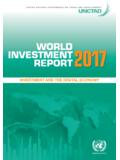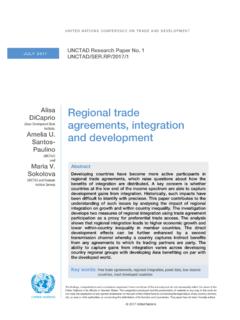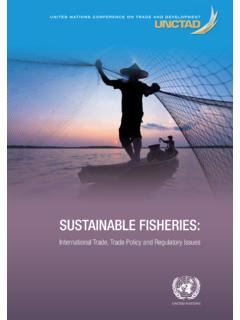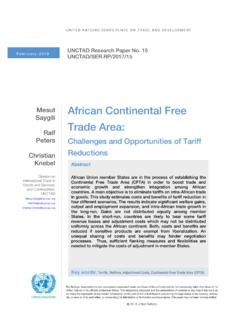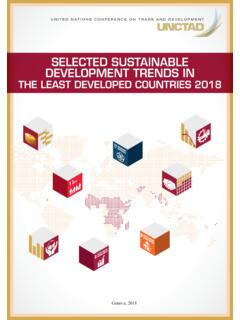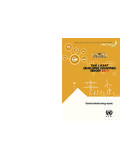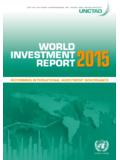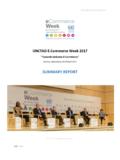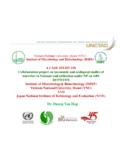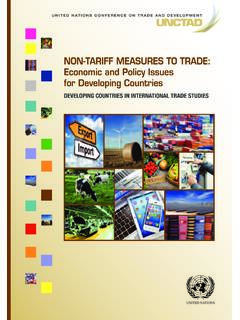Transcription of AFRICAN CONTINENTAL FREE TRADE AREA: Policy and ...
1 U n i t e d N at i o n s C o n f e r e n c e o n T r a d e A n d D e v e l o p m e n t AFRICAN CONTINENTAL Free TRADE Area: Policy and Negotiation Options for TRADE in Goods UNITED NATIONS CONFERENCE ON TRADE AND DEVELOPMENT. AFRICAN CONTINENTAL FREE TRADE AREA: Policy and Negotiation Options for TRADE in Goods New York and Geneva, 2016. Note The material contained in this publication may be freely quoted or reprinted but acknowledgement is requested, together with a reference to the document number. A copy of the publication containing the quotation or reprint should be sent to the UNCTAD Secretariat, at: Palais de Nations, 1211, Ge- neva 10, Switzerland. The designations employed and the presentation of the material do not imply the expression of any position whatsoever on the part of the United Nations Secretariat concerning the legal status of any country, territory, city area, or its authorities, or concerning the delimitations of its frontiers and boundaries, or regarding its economic system or degree of development.
2 The views expressed in this publication reflect solely the views of the author. This is an unedited publication. Acknowledgements This report was prepared for UNCTAD by Mr. Magdi A. Farahat under the framework of a Develop- ment Account Project 1213 AR on "Strengthening Capacities of AFRICAN Countries in Boosting Intra- AFRICAN TRADE ". It was supervised by Mr. Bonapas Onguglo, Senior Economic Affairs Officer, UNCTAD, and Mr. Ahmed Mukhtar, Economic Affairs Officer, UNCTAD. It was also reviewed by Mr. Joseph Kodzo Banini, consultant with UNCTAD. UNCTAD/WEB/DITC/2016/7. Copyright United Nations, 2016. All rights reserved Table of contents INTRODUCTION .. 1. CHAPTER 1: BOTTOM UP OR TOP DOWN INTEGRATION .. 2. CHAPTER 2: REQUIREMENTS FOR ESTABLISHING FTAS IN GOODS .. 4. : TRADE in goods .. 4. : Rules of Origin .. 6. : TRADE Facilitation.
3 8. : Non-tariff measures and barriers .. 9. : Other areas of importance .. 11. CHAPTER 3: INTRA- AFRICAN TRADE IN GOODS .. 13. : TRADE Flows in select RTAs and across Africa .. 13. : Applicable ROOs, TRADE Facilitation and NTMs .. 15. : Tariff Liberalization Options .. 16. Harmonisation of Macro-economic Policies .. 18. CHAPTER 4: KEY CONSIDERATIONS FOR ACCELERATED CFTA NEGOTIATIONS .. 20. : The Negotiating Mandate .. 20. : The Negotiating Team .. 20. : The Negotiating Process .. 21. : The Negotiation Content .. 22. : The CFTA as a supra-regional agreement .. 22. : Inclusiveness and Transparency of Negotiations .. 23. : Leadership Roles and the AU .. 23. : Retaining Policy Space for Regional Development .. 24. : Negotiations Timetables and Targets .. 24. CONCLUSIONS AND SOME SUGGESTIONS .. 25. 1. The role of AUC.
4 25. 2. RECs and the CFTA .. 25. 3. Dispute settlement .. 26. 4. Drafting a Balanced Agreement .. 26. BIBLIOGRAPHY .. 28. Figures Figure 1 : Trends Tariff versus NTMs .. 6. Figure 2:Estimations of NTMs Ad Valorem Equivalents (AVEs) for Africa .. 10. Figure 3: Share of intra- AFRICAN merchandise in total AFRICAN exports, 2000-2015 (in per cent) .. 13. Figure 4:Share of intraregional TRADE in selected RECs (2014, in per cent) .. 14. i ACRONYMS. AfDB AFRICAN Development Bank ARIA Assessing Regional Integration in Africa reports of UNECA. AU AFRICAN Union AUC AFRICAN Union Commission COMESA Common Market for Eastern and Southern Africa CFTA CONTINENTAL Free TRADE Area EAC East AFRICAN Community ECOWAS Economic Community of West AFRICAN States IGOs Intergovernmental Organizations FTA Free TRADE Area GATT General Agreement on Tariff and TRADE GTAP Global TRADE Analysis Project HATC High Level AFRICAN TRADE Committee HS Harmonized Commodity Description and Coding System NTMs Non-Tariff Measures OAU Organization of AFRICAN Unity OECD Organization for Economic Cooperation and Development RECs Regional Economic Communities RTA Regional TRADE Agreement ROO Rules of Origin SADC Southern AFRICAN Development Community TF TRADE Facilitation UNCTAD United Nations Conference on TRADE and Development UNECA United Nations Economic Commission for Africa WTO
5 World TRADE Organization ii INTRODUCTION. TRADE has been the motor of economic, social and political integration of AFRICAN countries for many centuries prior to the establishment of Africa's first regional body, the Organization of AFRICAN Unity (OAU), in 1963. The OAU strived towards boosting intra- AFRICAN cooperation and integration in the economic field at the CONTINENTAL level. It saw the formation of several regional economic communities that were created first with a view to consolidating the economic space of a particular region to harness potential benefits of such integration; and secondly, these would serve as the pillars or building blocks for eventual formation of a CONTINENTAL economic community. In 1980, the OAU adopted the Lagos Plan of Action for the Economic Development of Africa 1980-2000, articulating a regional development plan for Africa that included the formation of an AFRICAN Common Market.
6 While several programmes and institutional creation proliferated, the level and rate of implementation of TRADE integration programmes of many regional economic communities (RECs) faltered. Weak implementation at the RECs level meant that efforts towards building up the CONTINENTAL community also wavered. With a view to reviving and launching the CONTINENTAL integration project, the OAU Abuja Treaty Establishing the AFRICAN Economic Community was adopted in June It articulated the formation of a CONTINENTAL free TRADE area as a stepping stone toward the realisation of the AFRICAN Economic Community. Momentum towards implementing this objective gathered speed with the formation of the AFRICAN Union (AU) in 2002, replacing the OAU. AU member States paid greater attention to CONTINENTAL integration. In fact, Article 3 in the AU's Constitutive Act, establishes that the third objective of the AU is to accelerate the political and socio-economic integration of the continent.
7 Subsequently, the AU decided to concentrate the process of fostering CONTINENTAL economic integration through TRADE integration. At the 2012 AU Summit, Heads of State and Government adopted a Decision (Assembly/ (XVIII)) on the Establishment of a CONTINENTAL Free TRADE Area (CFTA) by the indicative date of 2017 and endorsed the Action Plan on Boosting Intra-Africa TRADE (BIAT) which identifies seven areas of cooperation namely TRADE Policy , TRADE facilitation, productive capacity, TRADE related infrastructure, TRADE finance, TRADE information, and factor market integration. Then in June 2015, at the twenty-fifth Summit of the AFRICAN Union, held in South Africa, AFRICAN Heads of State and Government agreed to launch negotiations on the creation of the CFTA by 2017 through negotiations on the liberalization of TRADE in goods and services.
8 This initiative presents major opportunities and challenges to boost intra- AFRICAN TRADE . In order to multiply the benefits of the CFTA and promote developmental regionalism in Africa, a comprehensive vision of TRADE and development needs to be in place. Expanded markets for AFRICAN goods and services, unobstructed factor movements and the reallocation of resources should promote economic diversification, structural transformation, technological development and the enhancement of human capital. The CFTA must be ambitious in dismantling barriers and reducing costs to intra- AFRICAN TRADE and in improving productivity and competitiveness. It must provide for governments to involve non- state actors, especially private sector, civil society and academia, in the discussions on the intent, content and design of CFTA so that the resulting agreement can create opportunities for businesses to exploit and bring about benefits to ordinary citizens.
9 2. 1. CHAPTER 1: BOTTOM UP OR TOP DOWN INTEGRATION. One of the key issues in relation to the achievement of AFRICAN CONTINENTAL integration was the relative priority that should be given to integration of the continent as a stand-along strategy, a top-down process, or through the integration of the different AFRICAN regional economic communities, a bottom up process. The Lagos Plan of Action and the Abuja Treaty embraced a bottom-up process with the formation of RECs which would then become the stepping stones for AFRICAN CONTINENTAL integration. Deep integration is envisaged in terms of a single common market, and economic and monetary union. Article 6 of the Abuja Treaty provided for the establishment of the AFRICAN Economic Community in six stages over period not exceeding thirty-four years. Basically the first stage would involve a strengthening of existing RECs and establishment of new RECs in regions where they do not exist.
10 The second stage would involve each REC stabilizing tariff barriers, and non-tariff barriers, customs duties and internal taxes. The third stage would involve at the level of each REC the establishment of a free TRADE area through the gradual removal of tariff barriers and non-tariff barriers to intra-community TRADE and the establishment of a customs union by means of adopting a common external tariff. The fourth stage would involve coordination and harmonization of tariff and non-tariff systems among the various RECs with a view to establishing a Customs Union at the CONTINENTAL level by means of adopting a common external tariff. The fifth stage would see the establishment of an AFRICAN Common Market through the adoption of common policies in several areas; harmonization of monetary, financial and fiscal policies; and the application of the principle of free movement of persons as well as the provisions herein regarding the rights of residence and establishment.
